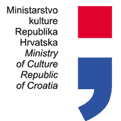
Opening of the KOTEKS Sports and Shopping Center, Split 1981 (Photo: Mario Javorčić)
MOTEL TROGIR
‘The East is west of the West’
—
Biennale of Young Artists from Europe and the Mediterranean (BJCEM) & Slobodne veze/Loose associations launch an open call for artists under the age of 35
MOTEL TROGIR: ‘The East is west of the West’
a collaborative project _ study visit / short term residency
PLACE OF THE RESIDENCY: Trogir/Split, Croatia
TIME OF THE RESIDENCY: September 11-15 2016.
–
SELECTION RESULTS
The members of the jury (Nataša Bodrožić, Lidija Butković Mićin, Ivana Meštrov and Saša Šimpraga) have selected the following artists (in alphabetical order) for the upcoming short term residency in Trogir and Split, in September 2016:
1. Katerina Duda (Croatia)
2. Pavel Khailo (Ukraine)
3. Marko Salapura (Serbia)
4. Katharina Swoboda (Austria)
5. Nikolas Ventourakis (Greece)
Additionally, the special mention of the jury goes to proposals by the following artists: Elisa Storelli, Silvia Amancei & Bogdan Armanu, Jan Domicz, Antonio Kiselić, Driton Selmani, Marijana Bucat, Timo Menke with whom we would like to develop some sort of collaboration in the near future.
We would like to thank everyone who participated in this call!
PROGRAM
September 11th-15th, 2016 | Split, Trogir, Makarska Riviera
SEPT 11th: Arrivals
SEPT 12th: Split tour: (Katalinka memorial/ Sports and Shopping Center Koteks/ Split 3)
SEPT 13th: Trogir tour by boat: (Motel Trogir/ Trogir Shipyard) +Babe Vineyard (evening)
SEPT 14th: Makarska Riviera tour by bus: Krvavica Children Health Resort, Brela (Hotel Maestral, Hotel Soline, Hotel Berulia) with swim breaks.
SEPT 15th: Departures
Every day will be combined with workshops scheduled in the first part of the day and guided tours in the afternoon.
About the project
The MOTEL TROGIR project is focused on preservation and (re)evaluation of the mid-20th century architectural heritage from the period of the Socialist Yugoslavia on the Adriatic coast (and beyond). As part of the annual artistic project, in collaboration with BJCEM, we invite artists under the age of 35 to join the short term residency/study visit to two mid Dalmatian towns, Trogir and Split, where they will be introduced to the spatial and social context in which this architecture was made to be. This year’s topic will be to examine how the story appears, relating it to the concrete context and the modernist built environment in mid Dalmatia. How we make stories of places we (do not) know? What influences our observation and perception of places, geographies with which we don’t have direct contact or previous knowledge based on experiencing?
The Theme
Driving along the Highway on the Eastern Adriatic coast, one can track the line of the (post WW2) modernist architectural heritage (often tourist architecture) from the late 1950s to the 1980s. If one searches for them, every now and then, one will find decaying structures standing by the road, at the edges of the coastal towns or along the sea line. Even though in many cases they lost their original function, often empty and in slight or greater decay, they are sort of silent witnesses of the social and economics conditions that were quite different from today. Their ownership status is often vague (due to non transparent privatization which occured in the 1990s), dimensions transgressive and design not quite fitting the dominant (architectural) scenery of today. Surrounded by the urban mess, paradoxically, they appear in space as some sort of “errors”, although being advanced structures defined by their pure forms, incorporating “emptiness”, forming generously spaces of common use. Once they were socially owned, they in fact belonged to people who worked in them (during Socialist period of Yugoslav workers self-management). The fact that they were conceived as extensions of the cities and nowadays stand half ruined, in-between, but in a way “open” make them accessible and thus, once again, “common”, no matter of their current (legal) ownership status. However, cut off from the context that enabled their existence, in the eyes of an accidental passer-by, they seem lacking the capacity to tell the story from where they have appeared, what made them standing there and why.
A narrative is some kind of retelling, often in words, of something that happened (a story). The narrative is not the story itself but rather the telling of the story. While a story is a sequence of events, a narrative recounts those events, perhaps leaving some occurrences out because they are from some perspective insignificant, and (maybe) emphasizing others. Narratives thus shape history (the series of events, the story of what happened).
The Motel Trogir project in 2016 has been supported by the Kultura nova Foundation, Ministry of Culture of the Republic of Croatia and BJCEM.


KOTEKS GRIPE, Sports and Shopping complex, designed by architects Slaven Rožić and Živorad Janković, 1979-1981, following the city development incited by the 1979 Mediterranean Games.

KOTEKS GRIPE, Sports and Shopping complex, designed by architects Slaven Rožić and Živorad Janković, 1979-1981, following the city development incited by the 1979 Mediterranean Games.

Motel Trogir (Motel Sljeme), designed in 1965 by Ivan Vitić, the central point of our campaign for preservation of the mid 20th century modernist architecture from the period of Socialist Yugoslavia (Photo: Duška Boban).

Motel Trogir (Motel Sljeme), designed in 1965 by Ivan Vitić, the central point of our campaign for preservation of the mid 20th century modernist architecture from the period of Socialist Yugoslavia (Photo: Duška Boban).

